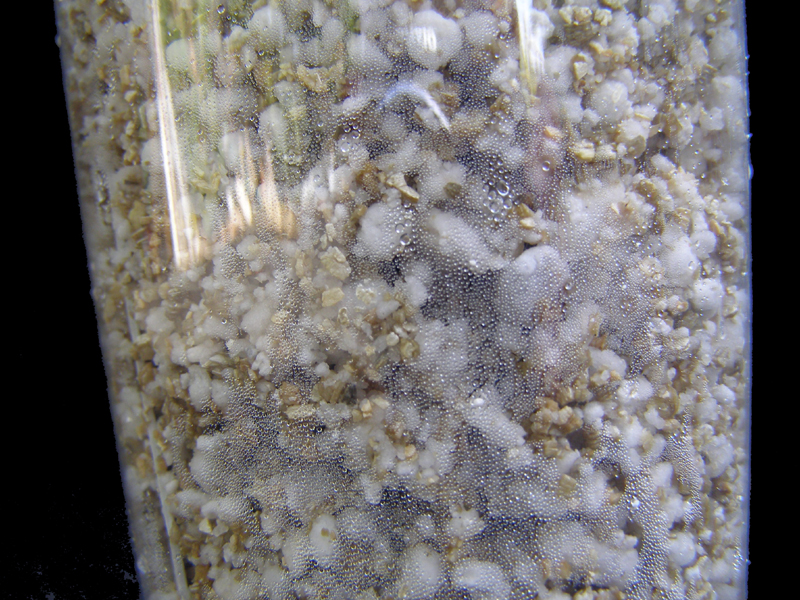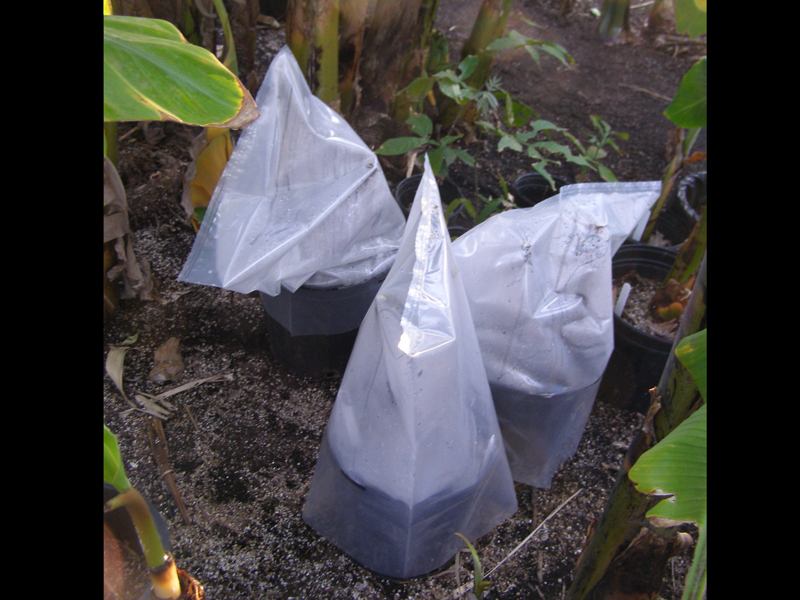- Prepare the Tools
- Sharp scissors or knife: clean and sterilized, so as not to infect the wound.
- Ashes: self-make from burned dry grass or newspaper, or grinding coal.
- Small flowerpot: For example, 3 inch flowerpot is commonly used for cuttage. If there is no flowerpot, you can also drill some holes at the bottom of blastic cups. Transplant pots will allow you to observe the root development easier.
- Rooting media: Ideally, you can use horticultural sand (acquired from construction shop or river bank. Washed and preferably sterilized with boiling water), or perlite, vermiculite (purchased from gardening shops).
- Thermometer
- Hygrometer
- Choose Proper Cuttings

- The cuttings should come from a healthy plant. The better the plant grows, the faster the cutting grows root after cuttage. In our experience, cuttages equal to or thicker than a mark pen is easier to survive. The thicker a cuttage is, the longer it can sustain, thus increasing the success rate.
- Length: About 15 centimeter with at least one growing point on the top or on the side. The nodes are healthy. Longer cuttings can also work; they may have higher survival rate while the resulted tree won't be better than shorter cuttings, and the length may make it difficult to be accommodated by the reproduction facilities.
- Timing: Spring, summer, fall, whenever the temperature is high. Spring and summer when the bodhi tree is growing rapidly is the best. In the case of using thick old branch, it is possible to do cuttage in the dormant period (winter), to prevent the case that new buds grow before new root is grown and causing the branch to dry out.
- Trim the Leaves

- Because leaves evaporate water, to avoid the branch from losing water too fast, it is better to remove all leaves except the new bud. When you cut the petiole, you may cut it closer to the leaf instead of to the stem, so as to minimize the loss of sap.
- It is better not to use any cutting with flower bud as flower bud sucks nutrition and hormone. If you need to use a cutting with flower buds, remove all flower buds.
- Cut the Cutting

- Cut it: Use a very sharp knife or scissors to cant the cutting smoothly and cleanly. If the wound is not clean, it is easier to be corrupted after putting into the soil. Sharp knife may be better than scissor as it makes cleaner cut, while please be cautious of your safty when using it.
- If you cut one cutting into many pieces, for the middle pieces you can cut it at least 1 centermeter above each node. This can prevent the nodes from fading. Avoid planting it upside down otherwise it may not grow root.
- Wound handling: To avoid leaking too much sap making the cutting too difficult to survive, cover the wound with ashes to seal the wound. Put it in a shade place until the wound is dry, which usually takes at most 2 hours.
- Do not use rooting hormone: Fig (including Bodhi tree) can root well without rooting hormone. Furthermore, it is possible that rooting hormone powder may break the seal from its dry sip and result in rotting, reducing the success rate. It is ok to use liquid rooting hormone with the right concentration. However, if the concentration is not ideal, it can bring negative result. Therefore, if you are not an expert, it is safer not to use rooting hormone on bodih tree. Note that rooting hormone is often strong acid so please handle with care and wash hand throughly without touching your eyes in the process.
- Carriage: The faster to plant a cutting after cutting off from a plant, the higher the success rate. If you cannot pot it soon, it is advisable to use lightly dampened clean paper towels or clean newspaper to cover the cutting, put it in an air-filled clean plastic bag after the wound is dry. The plastic bag can help keep high moisture. It is even possible for the cutting to grow root inside the bag. Avoid dipping the cutting in water, and open the seal to give it some fresh air every couples days, otherwise it will wilt due to lack of air. In case you send it from remote and there is no proper moisture for days resulting in the loss of moisture of the cutting, you can dip the bottom of the cutting in water (or Vitamin B1 water for plants) for around 2 hours before potting.
- Potting

- Rooting media: The medium should not have bacteria or any fertilizer. The cutting has no root to absorb fertilizer, while the fertilizer will make bacteria reproduce fast and endanger the cutting. To ensure ventilation, it is better to use coarse media instead of using soil/clay (tiny media). Ideally, you can use one of the following media:
- Water: About 1~2 inches of clean water can be the best rooting medium. Change the water every several days to keep it clean.
- Sand: Washed, fertilizer-free, salt-free sand. You must wash it first to remove tiny sands and mud, to allow better ventilation and remove bacteria.
- Vermiculite (fine/Number 2) and perlite: Mix with equal amount (1:1).
- Vermiculite (coarse/Number 3)
- Perlite
- Container: You can use a small flower pot. The most commonly used one for cuttage is 3 inch pot. Wash it with boil water once before use to remove any becteria.
- Use a pen or stick to dig a hole first and then put the cutting inside. To avoid wounding the cutting, do not pierce with the cutting. Apply water thoroughly afterwards. If you use water potting, just keep the cuttage slanted in the water, with the lower part in the water and upper part with the growing point(s) above water.
- Rooting media: The medium should not have bacteria or any fertilizer. The cutting has no root to absorb fertilizer, while the fertilizer will make bacteria reproduce fast and endanger the cutting. To ensure ventilation, it is better to use coarse media instead of using soil/clay (tiny media). Ideally, you can use one of the following media:
- Place the Pot Under Scattered Light

- Lighting: Scattered light can provide energy for photosynthesis and hormone generation, but direct sun light results in extensive vaporing, which wilt the cutting right away. Therefore, place the pot under scattered light and avoid direct sun light.
- Temperature: Maintain 25~30 degrees centigrade at all times. It will grow root in about a month. Do not pull the cutting out from rooting media to check if it roots; otherwise you would break the root. Avoid moving the pot if possible so as to minimize the possiblity of breaking the new root in the process.
- Facility: Professionals use heated propagators (bottom heat) or soil-warming cables to keep the temperature and speed up the growth of root. The ideal temperature for gorwing root is between 25~30 degress centigrade and when the soil temperature is a little higher than the air temperature. In Taiwan, as the temperature is usually warm, few people use heated propagators.
- If you use water potting, move the cuttage to a small pot with soil after you see roots.
- Keep Moisture

- Moisture: Once the cuttage have new shoots, if the leaves droop every now and then, it means it's lacking water due to not enough roots. In such case, keeping the moisture can help increase the success rate of bodhi tree reproduction with cuttage. (No need to keep moisture before there is new shoots.) You can cover the pot with one of the following approaches and leave a small breach to keep the relative humidity more than 70%:
- Cover the pot with a plastic bag.
- Cover the pot with a PET bottle.
- Put the pot in a big box (e.g. styrofoam box) Cover the box with cling film, and put a small cup of water in the box.
- Watering: Depending on the need, water the plant every couples days in order to keep the water content of the rooting media at around 60%. To prevent soaking the cutting, it is better not to water before the surface of the rooting media becomes dry. Avoid watering directly on the bud. Do not dip the bottom of the pot in water.
- Moisture: Once the cuttage have new shoots, if the leaves droop every now and then, it means it's lacking water due to not enough roots. In such case, keeping the moisture can help increase the success rate of bodhi tree reproduction with cuttage. (No need to keep moisture before there is new shoots.) You can cover the pot with one of the following approaches and leave a small breach to keep the relative humidity more than 70%:
- Gradually Relocate to Sunny Place After the Root is Strong

- After getting root, using a couple weeks to gradually pierce bigger holes on the plastic bag (or cling film), to prevent the plant from mildew and to make sure the plant will be used to normal moisture.
- When you see some root growing from the bottom hole of the pot, the root is growing strong. At this time you can transplant it into a bigger pot with proper soil described in the previous page. If you are new to cuttage, better keep the old rooting media around root together with the root into the new pot, so that you won't hurt the root by accident.
- After getting new leaves, relocate to sunny location gradually. Do not change the moisture and sunlight abruptly otherwise the plant will die. This domestication process may take about two weeks.
- You can finally relocate the plant to a place with full sunlight after confirming that the plant has got strong root which can absorb water well.
For more information, please see: